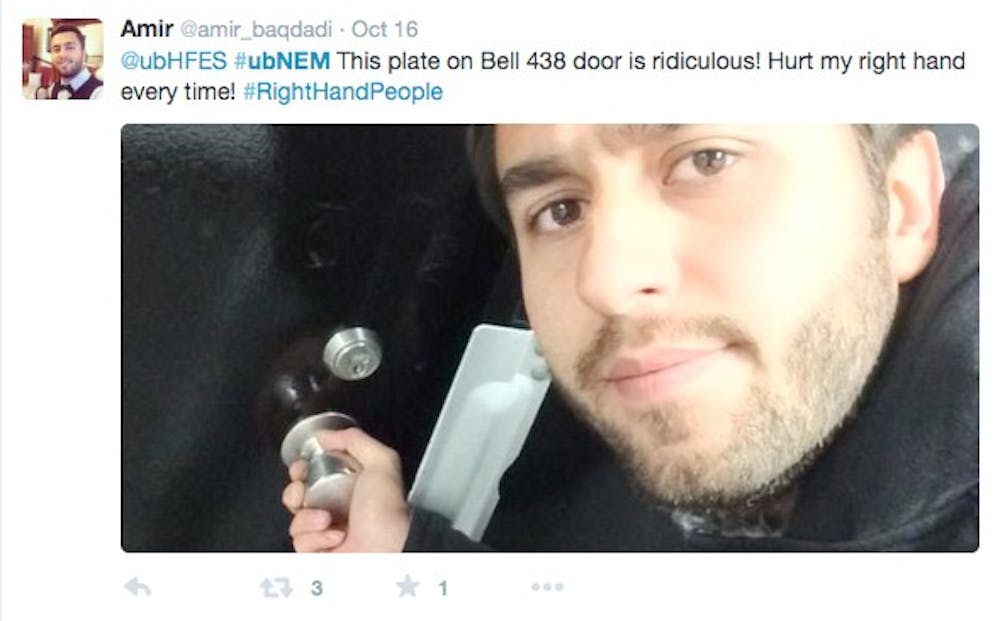How many times have you pulled on a door on campus, yanking on it a few times, only to finally realize it pushes open?
Most people have, according to Adam Houser, a human factors engineering Ph.D. student at UB, and president of its student chapter of the Human Factors and Ergonomics Society (HFES).
“People always say, ‘Ah, I’m so stupid I can’t figure out this door’… but you’re not stupid,” Houser said. “The point is to design in ways that are intuitive for people to understand and easy to use.”
This phenomenon is the basis of HFES’s campus-wide “bad design contest,” which invites students to take selfies with bad designs around campus and tweet them to @ubHFES.
Every October the national chapter of HFES celebrates ergonomics and each school’s charter incorporates an event to celebrate ergonomics and raise awareness about what it is to be a human factors specialist.
There are two parts of human factors engineering – a cognitive aspect and an ergonomics aspect. The ergonomics aspect is focused on physical functions, “concerned with work, how you do work, how you sit, your posture – everything you physically manipulate,” according to Houser.
Mahboobeh Ghesmaty, a human factors engineering Ph.D. student, thought the bad design contest would be the perfect way to get students focused on ergonomics that effect their day to day lives, whether they realize it or not.
“In the short term you might not notice it as much – for example, if you study in a really bad chair right before a test, it might not directly make you do worse but long term, if you aren’t paying attention to these things, you are really at increased risk of injury” Ghesmaty said.
Along with shaping what we as consumers look for in the products we purchase, the alternate goal of the bad design contest is to shift the blame from the consumer to the designer.
Whether it is technology, websites or chairs, it is important to HFES consumers realize that it isn’t so much their responsibility to know how to use things as much as it is designers’ responsibility to make sure that they function properly.
“Initially, we wanted to raise awareness about ergonomics and get people to pay attention to their surroundings,” Ghesmaty said. “But it is also important that people know their rights and needs as a consumer … we don’t want consumers to adapt to what we design, we want to learn what their needs are and how they are more comfortable and design for that.”
It is important to HFES to get students thinking about ergonomics in everyday life and their feedback through the bad design contest helps the human factors engineers in their studies.
“The goal of the human factors engineer is to design for everybody,” Houser said. “A good design is one that many people can use, not only a small portion of people can figure out … So it’s critically important for us to know how people use or try to use certain designs because it helps us when we are trying to design something.”
According to Ghesmaty, thinking about human factors can help undergraduate engineers who may not be aware of this particular field of engineering. Ghesmaty thinks even becoming slightly acquainted through something like this contest will make these people better designers in the future.
Students who participate in this bad design contest won’t only gain knowledge and awareness – prizes are offered for the top three worst designs submitted. First place receives a $50 Amazon gift card, second place receives a $25 restaurant voucher and third place receives two movie tickets.
Amir Baghdadi, a senior industrial engineer, tweeted his pain about the doors in Bell Hall.
“This plate on Bell 438 door is ridiculous!” Baghdadi tweeted. “Hurt my right hand every time #RightHandPeople.”
Other submitted tweets include dangerous stairwells and steps, unlabeled light switches and poorly designed bathroom amenities like toilet paper holders.
To participate in the contest, tweet a selfie of yourself and a bad design on campus to @ubHFES using the hashtag #ubNEM. The contest deadline has been extended to Friday October 23.
Sophia McKeone is a features staff writer. Features desk can be reached at features@ubspectrum.com.





